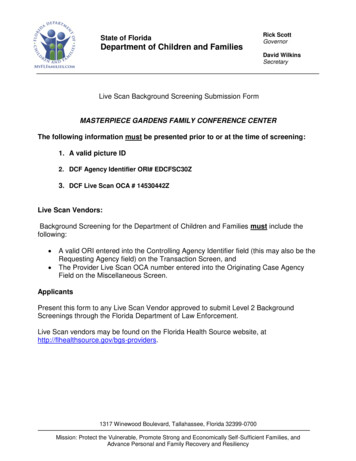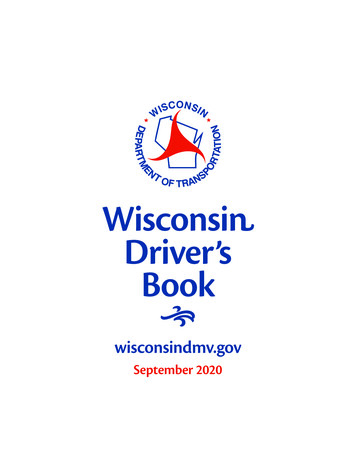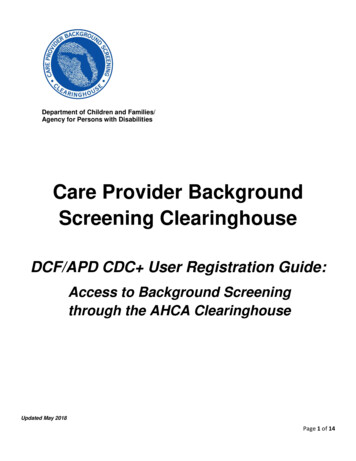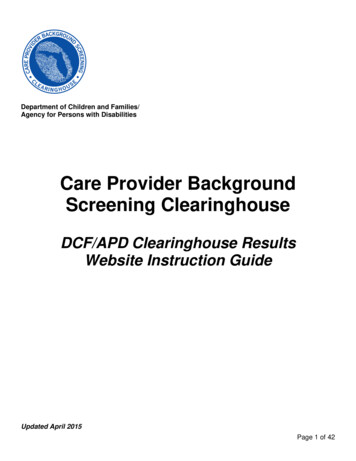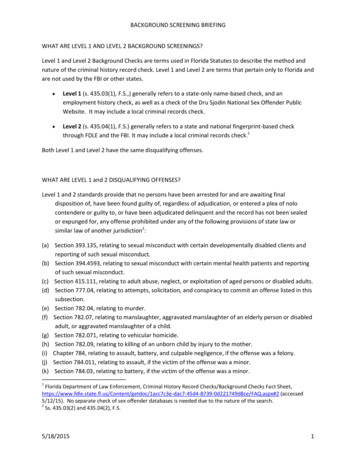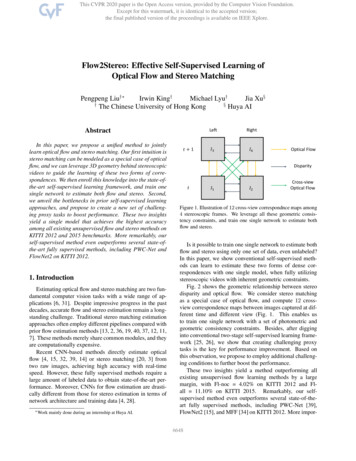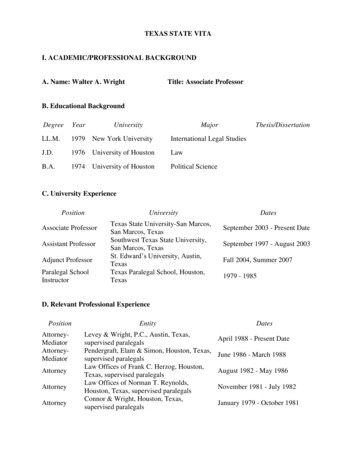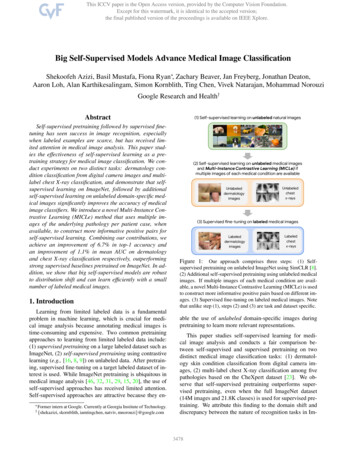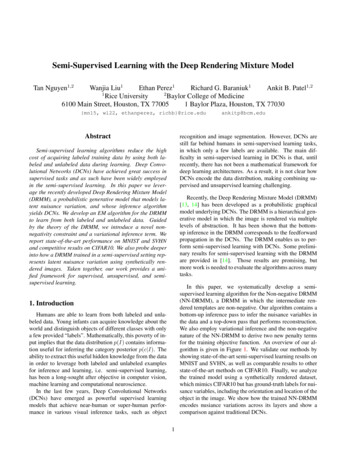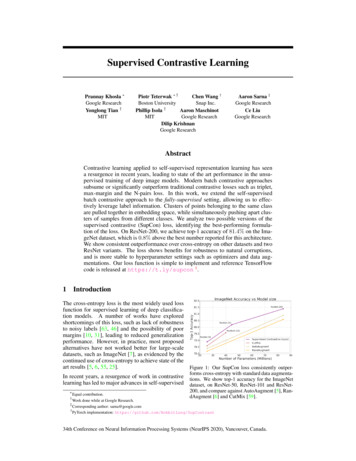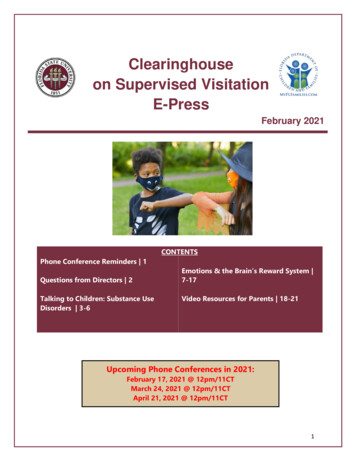
Transcription
Clearinghouseon Supervised VisitationE-PressFebruary 2021CONTENTSPhone Conference Reminders 1Questions from Directors 2Talking to Children: Substance UseDisorders 3-6Emotions & the Brain’s Reward System 7-17Video Resources for Parents 18-21Upcoming Phone Conferences in 2021:February 17, 2021 @ 12pm/11CTMarch 24, 2021 @ 12pm/11CTApril 21, 2021 @ 12pm/11CT1
Questions from DirectorsI am looking for a system that tracks my clients and funding sourcesfor those clients. Though we do use Quickbooks for internal use, isthere an associated database system to track clients from start tofinish, including accumulated grant or fee payment data, servicesand service hours, etc. Any suggestions?After spending some hours researching this, I can tell why you’re frustrated. I evencalled SVN, and they didn’t have any suggestions specifically for the for-profitcommunity. I found some numbers to call for free, like Free FastStartConsultation: (844) 687-6771 thena seems to have a lot of documentation space and a billing Also, there is a company in London called Child Assist Pro(https://www.childassistpro.com/features/) Email:support@techniframe.comIf I hear of any others, I’ll be sure to let you know.We have a client who had COVID-19 back before the holidays. Shesays she doesn’t need to wear a mask because she has antibodies,although I don’t know if she has been tested for them. Should weinsist on having her wear a mask (we give them out for free), or lether refuse one?Based on the CDC guidelines, I would recommend that you stick to your veryreasonable rule about mask-wearing. Remind your client that when she wears a mask,she is not wearing it to protect herself as much as she is wearing it to protect others.Remind her that COVID is a new illness that we don’t know enough about yet to be ableto know how long one person will stay immune after an illness. Can you imagine havingto find out exactly when people were sick, when they recovered, and how then guesshow long they might have immunity? Remind her that if you allow her to go without amask, other parents will not want to wear a mask, and that will put everyone at risk,including her child. My last recommendation is to emphasize the wellbeing of children.That’s your program’s purpose, and you want to be consistent with it.2
Talking about Parents’ SubstanceUse DisorderIntroductionMany families within the United States struggle with substance abuse; in fact, accordingto the Substance Abuse and Mental Health Services, 1 in 4 children in the United Statesare exposed to substance abuse within their homes. Because substance abuse is a verysensitive and mature topic, it would be difficult to explain to a child that what they’regoing through is not normal and it is definitely not their fault.Addiction is not a single victim disease; it also affects the loved ones of those who arebattling this illness. Often, children feel neglected due to the emotional unavailability oftheir parents. Children of addicts often experience emotional or physical abuse orneglect, domestic violence, lack of boundaries, and inconsistent messages about right orwrong. These children may also be predisposed to behavioral problems and to abusingalcohol or drugs themselves as they are more genetically inclined to, they may alsodevelop problems in school or social relationships.As children are greatly affected by their parent’s substance use disorder, it is highlyimportant to reassure them by letting them know that they did not cause their parent’saddiction and there is nothing they could do to prevent their parent from drinking orusing drugs. Be sensitive when speaking to them, remind them that their parent’s lovethem, and provide as much information as you can so that they aren’t felt wonderingand trying to create their own explanations. Most importantly, remind them that youare there to support them and that it is not their fault.Objectives: Addiction is a disease It is not your fault Identify other support system’s in a child’s life It’s okay to talk Help a child be a child The 7 C’s3
Addiction is a Disease:Every parent wants to be there for their child. However, this disease may get in the wayof their goals; for example, a parent may promise to show up for their child’s sportingevent or school play but regretfully forget their word they may be high or drunk. A childmay even feel embarrassed when a parent does show up to their school event drunk orwhen they slur their words when speaking to their teachers; a child knows that this is notnormal and may feel resentment for their parent for making them feel embarrassed orexposed to their peers. You must remind the child that these actions, or lack thereof,does not make their parent a “bad” person, they have an addiction which is a diseasethat they simply need treatment for.It is not Your Fault:Although it is normal for a child to ponder the idea that they could do something toprevent their parent from using drugs, it is not healthy. The child may feel like theycause too much stress on their parents and drive them to continue their addiction, someparents may even say things to cause the child to believe they are the cause like “It isn’teasy providing for you, I just need a break maybe if you would help me out sometimes Iwouldn’t be so stressed and do this.” Some older kids may even limit their social outingsin hopes that their presence will prevent their parent from abusing substances. Youmust remind the child that it is not their fault that their parent has a disease and thatthere’s nothing they can do to stop it, healing has to come from the user themselves.You are not Alone:Children of addicts often have to take care of themselves by making their own mealsand such, because of this they often take on a survival role and mentality. Showing thechild that they have a support system and there are people that love and care for them,whether it may be their grandparent, aunt, uncle, or a support group, it is important forthem to know that they are not facing this battle alone. Many kids may feel like they arethe only child going through this situation as well and reassuring that this happens tomany kids, even ones in their own school may bring them comfort.It’s Okay to Talk:Addiction is very taboo from a societal and familial perspective, because of this, manyparents may tell their children to not speak of their situation with others. This may lead4
children to conceal their emotions and worries. It is unhealthy to repress emotions andmay even lead to behavioral problems, this is why it is very important to encouragethem to speak to someone they trust like a grandparent, aunt, uncle, teacher orcounselor.Help a Child be a Child:Children of those who suffer from substance use disorders may often mature quickerthan their peers. They take on responsibilities they should not have to and it isimportant to remind them that they are still kids and allow them to find age-appropriatehobbies and pastimes to promote a sense of normalcy to their lives. It is important forthem to feel included by their peers by spending time with their friends and beinginvolved in activities that make them happy.The 7 C’s:I did not cause thisI cannot cure itI cannot control itI can care for myselfBy communicating my feelings,Making healthy choices, andBy celebrating myself!5
References:T. Buddy, “How to Talk to Children About Family Substance Abuse.” Verywell Mind, 5Oct. 2020, -parents-addictiion66633.“Talking to Kids About Their Parents’ Addiction.” U.S. News & World Report, U.S. News& World Report, ction.“Talking to Children About a Parent’s Substance Abuse.” The Oaks at La PalomaTreatment Center, 3 Mar. 2015, tparents-substance-abuse/.6
Emotions and the Brain’s RewardSystemBy Dana White and Richard BritoIntroductionAs humans, we all experience emotions, and both negative and positive emotions areencountered throughout our lives. However, we usually want to experience positiveemotions. Positive emotions occur when our internal reward system is activated. Parentscan utilize the following ideas and suggestions to create healthy habits that can lead topositive emotions.Objectives Understand the 27 emotions humans experienceUnderstand how the brain’s reward system worksUnderstand the effects of natural chemicals on human functionalityUnderstand the effects of cortisol on the brain and the bodyUnderstand the body’s way of processing stressLearn about the effects of substances on the brain’s reward systemLearn about how certain activities encourage healthy habitsHuman EmotionsEvery human experiences the same 27 emotions duringtheir lifetime. These emotions can be experienced daily orcan be felt less frequently. The emotions humans canexperience include: AdmirationAdorationAesthetic appreciation: admiration of beautyAmusementAnxiety: a state of increased arousal turned intodistressing worry that negatively effects multiplebody systemsAweAwkwardness7
BoredomCalmnessConfusionCravingDisgustEmpathetic pain: understanding someone else’spain Entrancement: feeling delighted Envy Excitement Fear Horror Interest Joy Nostalgia: the feeling of longing for things of the past Romance Sadness Satisfaction Sexual desire Sympathy Triumph(Cowen & Keltner, 2017) Emotions that we experience can be both positive and negative. Naturally, we desire tohave more positive emotions than negative emotions. Positive emotions areexperienced through the brain’s reward system.The Brain’s Reward SystemAs humans, we crave positive emotions. We experience these positive emotions whenour brain releases dopamine. Dopamine is a neurotransmitter in the brain that makes usfeel good and increases the body’s level of arousal. To continue experiencing thispositive emotion, we continue to engage in the act that caused this pleasurableexperience. This cycle is referred to as the brain’s reward system which is shown in thediagram below.8
Engage inbehaviorPositiveemotionRelease ofdopamineHuman FunctionalityOur brain is filled with all sorts of chemicals that have all sorts of functions on the brainand body. Below are the main chemicals found within humans and their respectiveimpacts on the mind and body: Melatonin- prevention of weight gain and helps individuals sleepGABA- inhibits neuron activation which allows individuals to relax and tofeel calm Glutamate- is responsible for excitatory functions within the body such asalertness, enhanced cognitive functions, and enhanced attention Cortisol- maintains blood pressure, regulates one’s metabolism, and isreleased in response to stress Adrenaline- responsible for fight, flight, and freeze response, responsiblefor increasing blood flow circulation to one’s muscles, and in regulatingvisceral functions which comes from one’s internal organs(Adrenaline, n.d.; Cherry, 2020; Figueroba, 2019; Martínez, 2019)In addition to the chemicals listed above there are other neurotransmitters in our brainsthat, when released, make us feel happy among other benefits which are listed below:9
DopamineEndorphins The reward chemical. The pain killer.Oxytocin The love horomone.Serotonin The mood stabilizer.Understanding StressCortisol is known as the stress hormone that is found within one’s body. Cortisol isresponsible for the maintenance of blood pressure, blood sugar, regulation of one’smetabolism, and the brain’s response to stress. There are two forms of cortisol that havedifferent functionalities within the brain and body which are listed below:1. Basal Cortisol Basal cortisol are the resting levels of cortisol (the amount of internalstress) found in our day-to-day lives Basal cortisol elevation causes damage to the hippocampus (which isresponsible for memory formation, thus memory formation is impaired solearning retention rates significantly drop) Basal cortisol elevation causes damage to one’s memory-sensationconnection and causes other adversities to the body (one does not feelconnected to their senses and past experiences) Having elevated basal cortisol levels means that one’s resting stress levelsare heightened in one’s body compared to the normal amount of stressthat supports productivity10
Having elevated basal cortisol also impairs hippocampus-dependentlearning (which is responsible for one’s self-awareness capabilities),memory formation, and memory storageHaving chronic or life-long high basal cortisol levels causes functionalatrophy (cellular death) which leads to system impairment of thehypothalamic-pituitary-adrenal axis (HPA is responsible for the modulationof the body’s inflammation response), the hippocampus, the amygdala(responsible for emotional regulation), and the frontal lobe (responsiblefor logic and reasoning) are all impacted within the brain2. Reactive Cortisol Reactive cortisol is cortisol release in reaction to external stressors Reactive cortisol is mainly caused by external stressors that are out ofone’s control which only exacerbates the internal levels of cortisolproduction which leads to even more cellular death Having high levels of cortisol leads to more cellular death which can causechest pain, anxiety, depression, heart attacks, strokes (coagulations ofone’s blood within the body or brain), and other adversities to the bodyand brain(Sroykham & Wongsawat, 2019)The Effects of Substances on the Human Reward SystemMost of the time, the brain’s reward system rewards positive behavior and helps uscreate healthy habits. Other times, we engage in unhealthy or harmful behaviors inorder to experience the “feel good” emotions associated with the release of dopamine,such as drug use. The use of drugs can cause a massive surge of dopamine in the brain.The effects are listed below: The amount of dopamine that is produced from the use of drugs is far more thanone would experience during a meal or through other natural reward processes.The amount of dopamine released by drugs tends to be anywhere from two toten times higher than natural rewards, and this “feel good” sensation that comesfrom drugs usually lasts much longerOne’s body builds a tolerance to the drug(s) and more is required then once usedThis constant exposure makes the body become accustomed to having drugs bethe source of one’s production of “feel good” feelings which reduces the body’snatural production and processing of dopamine.Excessive production of dopamine through drugs leads to drug-use becomingthat much harder to quit11
Drugs can activate neurons because their structure is similar to neurotransmitters.This similar structure allows drugs to attach to neurons and activate them, whichreleases dopamine and endorphins.(Drug Abuse, Dopamine and the Reward System Explained - The Cabin, 2018). Activities That Positively Benefit Humans’ Reward SystemAfter engaging in unhealthy habits, the brain is able to change and heal under beneficialconditions. This process is called neuroplasticity. Neurons in the brain are able to makenew connections when we engage in healthy activities that release “happy”neurotransmitters. Instead of engaging in unhealthy or harmful behaviors, parents canfind healthy ways to activate the brain’s reward system. It is important for our bodies torelease these neurotransmitters because it prevents us from experiencing deficits in ourmental health, such as anxiety or depression. In addition to mental health therapy,examples that have been proven through research are shown below.1. Exercise:Researchers have concluded based on the overwhelming evidence that exists thathaving lifelong exercise is associated with the following benefits:A longer health span outcomeThe delaying of the onset of 40 chronic conditions/diseasesThe body becomes capable of learning mechanisms because exercisesustains and improves quality of life through the engagement and activityof muscles and bones Endurance exercise training positively effects cardiovascular fitness Stronger muscles are formed from endurance training which benefits one’smental health resilience(Ruegsegger & Booth, 2018) 2. Yoga:Researchers have concluded based on the overwhelming evidence that exists thatengaging in yoga is associated with the following positive benefits: There are beneficial effects demonstrated that yoga is essential forimproving pain-associated disability and mental health (Büssing et al.,2012)Experienced yoga practitioners demonstrated that the brain increasedone’s GABA levels after a session of yoga which could potentially benefitindividuals with low GABA levels (Streeter et al., 2007)12
People who cannot naturally produce a calming effect include those thathave depression and anxiety disorders (Streeter et al., 2007)Abnormalities in HPA (HPA is responsible for the modulation of the body’sinflammation response) causes excessive production of cortisol and it isknown as Hypercortisolemia (Thirthalli et al., 2013)The inflammation response is usually occurring when the body is exposedto a foreign body or when the body is put through a stressful situation(Thirthalli et al., 2013).Hypercortisolemia can cause depression and yoga has been demonstratedto reduce levels of stress through the reduction of cortisol levels (Thirthalliet al., 2013)Researchers found that more patients in the yoga groups had a drop incortisol levels compared to the group that received drug-only as anintervention (Thirthalli et al., 2013).In the yoga-only group, the cortisol drop correlated with the drop in theHamilton Depression Rating Scale which demonstrated an antidepressanteffect on the body and mind (Thirthalli et al., 2013)Researchers found that subjects that participated in yoga had a greaterimprovement in their mood and a greater decrease in anxiety than that ofsubjects that only walked (Streeter et al., 2010)It was also found that there were positive correlations between improvedmood and decreased anxiety and thalamic GABA levels (thalamic GABAlevels has to do with controlling one’s attention and controlling one’ssensory processing) (Streeter et al., 2010)Researchers noted that subjects in the yoga group had positivecorrelations between one’s changes in their mood scales and changes intheir GABA levels (Streeter et al., 2010).Changes such as increased GABA levels causes a calming effect and thiscan be done through yoga (Streeter et al., 2010)3. Sunlight:Researchers have concluded based on the overwhelming evidence that exists thatengaging in a balanced and brief sun-exposure is associated with the following positivebenefits: Vitamin D production occurs with sun-exposureBrief optic-exposure (seeing daylight) to daylight allows melatoninproduction in the nighttime which is what allows someone to sleepMelatonin which is a pineal hormone serves as a pacesetter for many ofthe body’s natural circadian rhythms (sleep-rhythm)13
Melatonin also plays a crucial role a countering infection, inflammation,cancer, and in increasing autoimmunity within the bodyMelatonin reduces cytokines (can be toxic to the body) which are proteinsthat are built and elevated in people with sleep-disturbancesMelatonin suppresses ultraviolet radiation-induced skin damage whichcounters the effects of one’s exposure to sunlight if done in excessUltraviolet radiation causes increased blood levels of the body’s naturalopiates called endorphins which are responsible for reducing stress and inreducing feelings of pain(Mead, 2008)Healthy and worthwhile activities that will release these various neurotransmitters andmake us feel happier are listed below:Dopamine Eat nutritious foodsExercisingListening to musicMeditatingSpend time in natureEndorphins LaughEat dark chocolateGet a mssageMeditateExerciseOxycotin YogaSpend time with friendsHug someoneDo something nice for someonePet an animalSerotonin Practice gratitudeExposure to bright lightSpend time outsideExerciseEat foods with tryptophan14
ConclusionOf the 27 emotions we can experience, humans want to experience positive emotions.These positive emotions are experienced when certain neurotransmitters are releasedfrom the brain. There are many healthy activities parents can participate in that will leadto a release in dopamine, creating positive emotions.ReferencesAdrenaline. (n.d.). Retrieved January 30, 2021, ncos, I. (Ed.). (2018, December). Serotonin. Serotonin Hormone Health n.Büssing, A., Michalsen, A., Khalsa, S. B., Telles, S., & Sherman, K. J. (2012). Effects ofyoga on mental and physical health: a short summary of reviews. Evidence-basedcomplementary and alternative medicine : eCAM, 2012, 165410.https://doi.org/10.1155/2012/165410Cafasso, J. (2017, July). Endorphins: Functions, Levels, and Natural Boosts Healthline. Healthline. y, K. (2020, November 24). How Neurotransmitters Work and What They Do.Retrieved January 30, 2021, from tter2795394#: :text owen, A. S., & Keltner, D. (2017). Self-report captures 27 distinct categories ofemotion bridged by continuous gradients. Proceedings of the National Academy ofSciences of the United States of America, 114(38), 114DeAngelis, T. (2008, February). The two faces of oxytocin. Monitor on cin.15
Drug Abuse, Dopamine and the Reward System Explained - The Cabin. (2018,August 27). Retrieved January 30, 2021, use-dopamine-and-the-rewardsystemexplained/#: :text n%20usually%20lasts%20much%20longer.Figueroba, A. (2019, March 08). Neurotransmitters: Definition, 10 Main Types andFunctions. Retrieved January 30, 2021, ttersJulson, E. (2018, May 10). 10 Best Ways to Increase Dopamine Levels Naturally.Healthline. se-dopamine.Martínez, G. (2019, January 22). Melatonin: Benefits, Foods with Melatonin andSide Effects. Retrieved January 30, 2021, from ninMead M. N. (2008). Benefits of sunlight: a bright spot for humanhealth. Environmental health perspectives, 116(4), tional Institute on Drug Abuse. (2020, July 10). Drugs and the Brain. NationalInstitute on Drug Abuse. sbehavior-science-addiction/drugs-brain.Raypole, C. (2020, May). 12 Ways to Boost Oxytocin Naturally. o-increase-oxytocin#yoga.Ruder, D. B. (2019, June 19). Screen Time and the Brain. Screen Time and the Brain Harvard Medical School. gsegger GN, Booth FW. Health Benefits of Exercise. Cold Spring Harb PerspectMed. 2018;8(7):a029694. Published 2018 Jul 2. doi:10.1101/cshperspect.a029694Scharff, C. (2013, February 5). Neuroplasticity and Addiction Recovery . PsychologyToday. covery.16
Sroykham, W., & Wongsawat, Y. (2019). Effects of brain activity, morning salivarycortisol, and emotion regulation on cognitive impairment in elderlypeople. Medicine, 98(26), e16114. r, C. C., Jensen, J. E., Perlmutter, R. M., Cabral, H. J., Tian, H., Terhune, D. B.,Ciraulo, D. A., & Renshaw, P. F. (2007). Yoga Asana sessions increase brain GABA levels: apilot study. Journal of alternative and complementary medicine (New York, N.Y.) , 13(4),419–426. https://doi.org/10.1089/acm.2007.6338Streeter, C. C., Whitfield, T. H., Owen, L., Rein, T., Karri, S. K., Yakhkind, A.,Perlmutter, R., Prescot, A., Renshaw, P. F., Ciraulo, D. A., & Jensen, J. E. (2010). Effects ofyoga versus walking on mood, anxiety, and brain GABA levels: a randomized controlledMRS study. Journal of alternative and complementary medicine (New York, N.Y.) , 16(11),1145–1152. https://doi.org/10.1089/acm.2010.0007Sussex Publishers. Anxiety. Psychology xiety.Sussex Publishers. Dopamine. Psychology pamine#dopamine-and-behavior.Thirthalli, J., Naveen, G. H., Rao, M. G., Varambally, S., Christopher, R., & Gangadhar,B. N. (2013). Cortisol and antidepressant effects of yoga. Indian journal ofpsychiatry, 55(Suppl 3), S405–S408. https://doi.org/10.4103/0019-5545.116315Wei, M. (2017, September 11). There Are 27 Different Emotions, New StudySuggests. dy-suggests.Young, S. N. (2007, November). How to increase serotonin in the human brainwithout drugs. Journal of psychiatry & neuroscience : 077351/.17
Video Resources for ParentsInfants:1. This link, https://www.youtube.com/watch?v jskG0yVDMLk offers parentingadvice for new parents with infants. This video is hosted by TEDx Talks and thespeaker is Diana Eidelman. The video is 12 minutes and 29 seconds long. Thisvideo highlights possible experiences of new mothers or fathers and their senseof conflict of interest that may occur like comfort vs caretaking. A parent maywant to relax after a long day of work or after taking care of their baby. DianaEidelman mentions how there is no guidance and how one may feel overworked.There may be a sense of no achievement that may arise from the parent andthese feelings are completely normal. Focusing on the psychology of the parentand the child are crucial.2. This link, https://www.youtube.com/watch?v CyVYnYKzjygoffers advice for parents that are overwhelmed andemphasizes that self-care is not selfish. The speaker is LizCarlile, and it is hosted by TEDx Talks. The video is 9minutes and 27 seconds long. From the worries of havingprenatal vitamins, to birth, to raising an infant, taking careof one’s child is difficult. It is crucial for one to take care ofthemselves to be able to provide the most efficient care toone’s child. If one does not take care of themselves thenhow are they going to efficiently provide the requiredsupport that an infant requires? This video addressesMom’s Guilt and how to counteract it.18
Toddlers:1. This link, https://www.youtube.com/watch?v OUSss6imZOM demonstrates toparents the developmental stages/milestones of toddlers. Learning this willallows parents to successfully track their child’s social developmental milestonesup to three years of age. The spokesperson is Catherine Crowley, J.D., Ph.D. fromTeachers College, Columbia University. The video is 11 minutes and 25 seconds.The video outlines what the norm should be from birth to age three.2. This link, https://www.youtube.com/watch?v H14NNUYwVc offer teachings on an evidence-basedpractice technique that can be used by parents tohelp their children with emotional regulation. TheTechnique is called RULER and stands forRecognizing, Understanding, Labeling, Expressing,and Regulating. This video is offered by YaleUniversity and is four minutes and 53 seconds long.19
3. This link, https://www.youtube.com/watch?v 6fL09e8Tm9c is a Ted Talk by LaelStone and it is 12 minutes and 11 seconds long. This video teaches parents onhow to raise emotionally intelligent children. The video describes how societyvalues IQ more than EQ, when in reality it is recommended to focus on both.Adolescents:1. This link, https://www.youtube.com/watch?v VzflpW91yMg offers insight on howto turn parent-teen stress into parent-teen success. Neil D Brown is the guestspeaker, and it is hosted by TEDx Talks. The video is 12 minutes and 14 secondslong. This video addresses two keyways to bypass conflict and pain within thedynamic of a parent and an adolescent. As an adolescent grows older it isimportant to encourage accountability notjust to please their parent but to pleasethemselves. The two ways are as follows: 1)reclaim the wonderful qualities of your sonor daughter within your mind and 2) stoptrying to change and control their son ordaughter because that is the responsibilityof the adolescent. This can be done throughthe addition of privileges for goodbehavior.2. This link, https://www.youtube.com/watch?v S05PBOIdSeE offers insight toparents on the needs of adolescents and teenagers to thrive in society. Thespeaker is Charisse Nixon who is a developmental psychologist, and it is hostedby TEDx Talks. The video is 29 minutes and two seconds long. The protectivefactors of adolescents as well as their strengths are highlighted. Human are20
hardwired to connect, and spirituality isincluded within that hardwired connection.Among the most significant protectivefactors was found to be connection to anon-parent or adult and spiritual meaning.This video encourages parents to discussthese topics to develop a strong emotionalstability from within.Teens:1.This link, https://www.youtube.com/watch?v 0vdPxLfAsqo offers insight onparenting from a teen’s perspective. The speaker is Lucy Androski, and it ishosted by TEDx Youth. The video is five minutes and14 seconds. Lucy mentions that parents should notset restrictions that the parents cannot
experienced through the brain's reward system. The Brain's Reward System As humans, we crave positive emotions. We experience these positive emotions when our brain releases dopamine. Dopamine is a neurotransmitter in the brain that makes us feel good and increases the body's level of arousal. To continue experiencing this
